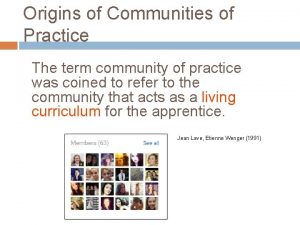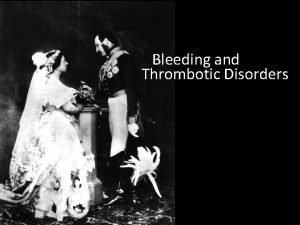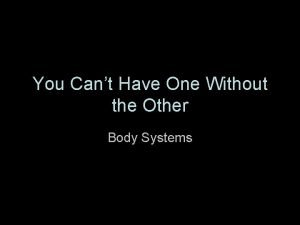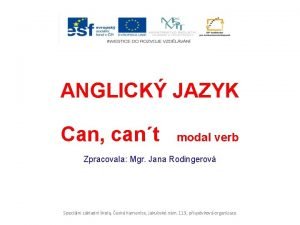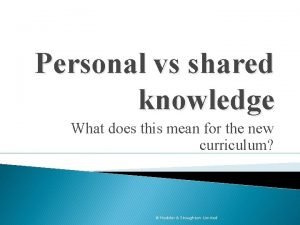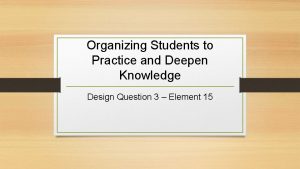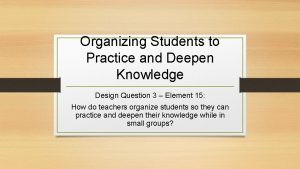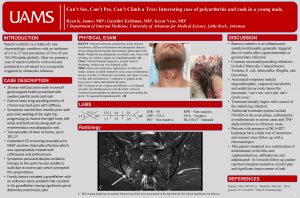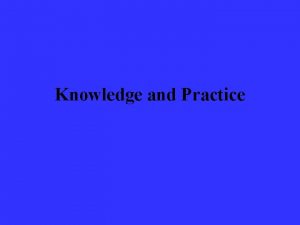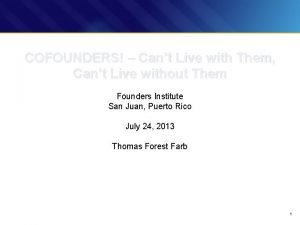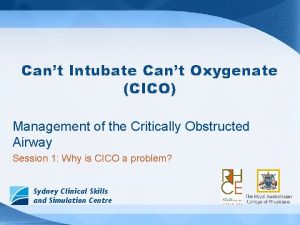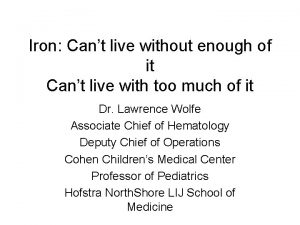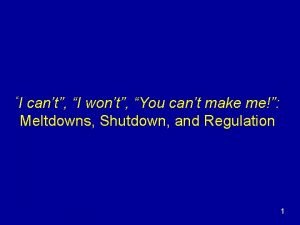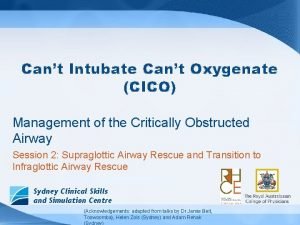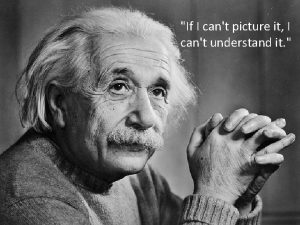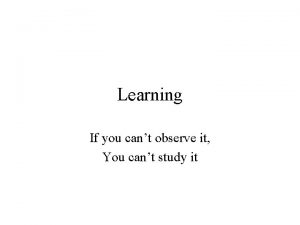Communities of Practice Communities of Practice Knowledge cant








































- Slides: 40

Communities of Practice

Communities of Practice Knowledge can’t be separated from its community and managed like inventory from a distance. It is part of the shared practice of communities that need it, create it, use it, debate it, distribute it, adapt it and transform it. Knowledge as a property of community is not static; it involves interactions, conversations, actions, and invention. For example, what constitutes scientific knowledge is the prerogative of the scientific community (theories, procedures, methods) and results in a body of knowledge. 2

Co. P Definition “… a group of professionals informally bound to one another through exposure to a common class of problems, common pursuit of solutions, and thereby themselves embodying a store of knowledge” - Manville and Foote 1996 3

Defining Communities of Practice • Communities of practice (Co. P) are living repositories of knowledge. • Members of a community are informally bound by what they do together. • The community and the degree of participation are inseparable from the practice. • Shared practices serve as a living curriculum for the apprentice 4

Dimensions of Co. Ps • What it is about • A joint enterprise as understood and continually renegotiated by its members. • Shared identification fueled by personal investment in a topic of interest • You know what your community cares about and what questions to ask; you understand the value of lessons learned • How it functions • Mutual engagement that bind members together into a social entity. • Learn from one another, interact, dynamic negotiation; trust develops • What capability it has produced 5 • the shared repertoire of communal resources (routines, sensibilities, artifacts, vocabulary, styles, etc. ) that members have developed over time. • You can’t be a real engineer unless you’re familiar with its repertoire of community: language, laws, cases, rules of thumb; doctor/boundary

Snapshot Comparison In perspective with other organizational groupings. Who belongs Formal Hierarchical organization reporting Purpose To deliver a product or service Project Management To accomplish Team assigned a specific task Community Voluntary, Build & of Practice invited or self- exchange selected knowledge Informal Friends and Collect & pass network acquaintances on information 6 Cohesiveness Duration Organizational Until next goals reorganization Project goals Passion, identity, commitment Mutual needs, friendship Until project is complete As long as interest remains As long as reason to connect exists

Why Support Co. Ps? • Formal knowledge management is not enough. • There is greater potential for information flow when Co. Ps are supported. • Innovative solutions can arise at boundaries between Co. Ps. 7

Where are they found? • Within businesses: • Occurs as people address recurring sets of problems. Ex. Claims processors, nurses in a ward, etc • Across business units • Cross functional. Ex. Chemical company’s safety managers in each business unit who gain from interacting regularly, solving problems, developing common guidelines. Develop a strategic perspective that transcends the fragmentation of organizational lines. • Across company boundaries. 8 • Computer engineers working for competitors form community to deal with technological changes • Oil companies (direct competitors)

What Co. Ps are Not • A community of practice is different from a business or functional unit. • Purpose is to develop knowledge not allocate resources • Power doesn’t derive from reporting relationships but rather from ability to contribute knowledge • Focused on own tasks so learning can remain local • A community of practice is different from a team. • Defined by knowledge not task. • Teams dissolve when project is complete. • Temporary therefore learning can be lost • A community of practice is different from a network. • About “something” not just relationships 9

People belong to Co. P and other Structures • In their business units, workers shape the organization and deliver products and services. • In their teams, they take care of projects and find solutions. • In their networks, they form relationships and spread information. • And in the Co. P, they develop the knowledge that lets them do these other tasks (best practices, lessons learned, feedback, “fill the white spaces in the org chart!”) 10

Types of Co. Ps • • • 11 Unrecognized. Bootlegged. Legitimized. Strategic. Transformative.

Unrecognized Co. P • Definition: • Invisible to the organization and sometimes even to members themselves. • Typical Challenges: • Lack of reflexivity, awareness of value and of limitation. 12

Bootlegged Co. P • Definition: • Only visible informally to a circle of people in the know. • Typical Challenges: • Getting resources, having an impact, keeping hidden. 13

Legitimized Co. P • Definition: • Officially sanctioned as a valuable entity. • Typical challenge: • Scrutiny, over-management, new demands. 14

Strategic Co. P • Definition: • Widely recognized as central to the organization's success. • Typical Challenge: • Short-term pressures, blindness of success, smugness, elitism, exclusion. 15

Transformative Co. P • Definition: • Capable of redefining its environment and the direction of the organization. • Challenge: • Relating to the rest of the organization, acceptance, managing boundaries. 16

Importance of Co. Ps to Organizations • An effective organization is comprised of a constellation of interconnected Co. Ps. • Each deals with a specific aspect of the company's competency. • It is by these communities that knowledge is “owned” in practice. 17

Movement of Information • They are nodes for the exchange and interpretation of information. • Members know what is relevant to communicate and how to present information in useful ways. 18

Preservation of Knowledge • They can retain knowledge in “living” ways. • Communities of practice preserve the tacit aspects of knowledge that formal systems cannot capture. 19

Employee Identity • They provide homes for identities. • Identities manifest themselves in the jargon people use, the clothes they wear, and the remarks they make. • Supporting communities helps people develop their identities. 20

Co. P Boundaries • Radically new insights often arise at the boundary between communities. 21

22

Leadership of Co. Ps • Co. Ps often have more than one leader. • Leaders are chosen internally. • Leadership often doesn’t coincide with authority. 23

Types of Co. P Leadership • • 24 Inspirational (thought leaders and experts) Day-to-day (organizers of activities) Classificatory (organizers of information) Interpersonal (social leaders) Boundary (connect to other communities) Institutional (the official hierarchy) Cutting-edge (initiators)

Fostering Co. Ps • Communities of practice exist whether or not the organization recognizes them. • Many are best left alone. • A good number will benefit from some attention. 25

Legitimizing participation • Recognize the work of sustaining the Co. P. • Acknowledge the value of the Co. P. • Give members the time to participate in activities. 26

Negotiating • People work in teams for projects but belong to communities of practice. • The long-term benefits of Co. Ps are difficult to appreciate. • Pay attention to the opinion of Co. Ps on long term strategic decisions. 27

Leveraging Potential • The knowledge that companies need is usually already present in some form. • Fostering Co. Ps spreads knowledge to the people who need it. • Strong Co. Ps create their own solutions internally or externally. 28

Fine Tune the Organization • Management interest, reward systems, work processes, corporate culture, and company policies can suppress Co. Ps. • Do not micro-manage the community. 29

Co. P Support Teams • A company wide team or committee can support Co. Ps. • This sends the message that the organization values the work and initiative of communities of practice. 30

Distributed Co. Ps • Literature has shown no reason why a Co. P could not exist in a distributed environment. • Difficulties arise in the sharing of soft knowledge among distributed members. • Building trust, confidence and identity are problematic. 31

Distributed Co. Ps • Most relationships are made in a face to face meeting. • Face to face meetings are important even in distributed environments. • This sustains future communications but needs re-charging at periodic intervals. 32

Tools Enabling Dist Co. Ps • Interpersonal tools such as e-mail, instant messaging, video and voice conferencing. • Group communication tools such as newsgroups, forums • FAQs, forums can also maintain knowledge. 33

• "IS managers must find ways to facilitate the key activities of communities--problem solving and innovation. This will mean providing new application architectures that allow members to represent problems, build prototypes, and create solutions. These tools--for modeling, scenario development, and analysis--must be open, flexible, and easy to use by any member of the community. " (Harvesting Your Workers' Knowledge, by Brook Manville & Nathaniel Foote, Mc. Kinsey & Co 34

Negative Aspects of Co. Ps • Communities can become liabilities if their own expertise becomes insular. • Co. Ps can be difficult to define and identify, and are therefore hard to support. • Co. Ps can interfere with corporate organization. 35

Success stories • Shell E&P realizes annual benefits of $200+ million through its Co. P knowledge sharing • American Management Systems (AMS) estimates that their communities save the company between $2 -5 million per year and increase revenue by over $13 million • An international company formed communities to supplement their management development program 36

More success stories • Nynex cut service set-up time by 80% through the increased communication that communities bring • Andersen Consulting Education division • over half of eligible employees participating • sample groups: motivation, culture and learning, demographics, virtual classroom, Web technology, problem-based learning 37

Possible communities • • • sales (virtual meetings? ) e-business accounting issues workflow processes diversity (racial, gender, age, mental models) retirement community building technology utilization PC tech support business strategy • marketing strategy • data mining & analysis 38 • core competencies Based on needs determination

Cultivating communities of practice a quick start-up guide by Etienne Wenger Wh o st art? support Communities of practice can use some light-handed guidance and technology infrastructure. get going Starting to cultivate communities of practice as early as possible creates early examples that allow people to learn by doing. • Provide some process support, coaching, and logistic assistance • Identify needs and define adequate infrastructure without undue emphasis on fancy technology members short-term value organization Practice: the body of knowledge, methods, stories, cases, tools, documents long-term value • • • personal development reputation professional identity network marketability • Have a few pilot communities • • • strategic capabilities keeping abreast innovation retention of talents new strategies integrate encourage Why focus on communities of practice? problem solving time saving knowledge sharing synergies across units reuse of resources members and the sense of belonging • Articulate a strategic value proposition • Identify critical business problems • Articulate need to leverage knowledge • Conduct workshops to • • 39 • Community: the relationships among A strategic context lets communities find a legitimate place in the organization Communities of practice are a familiar experience, but people need to understand how they fit in their work. help with challenges access to expertise confidence fun with colleagues meaningful work of shared inquiry and of the key issues set strategic context educate • • • Domain: the definition of the area Communities of practice are groups of people who share a passion for something that they know how to do and who interact regularly to learn how to do it better. ere t educate management and potential members about the approach • Help people appreciate how communities of practice are inherently selfdefined and self-managed • Establish a language to legitimize communities and establish their place in the organization What elements to develop? What are communities of practice? • going as soon as possible Find communities to start with by identifying areas where there is potential and readiness Interview some prospective members to understand issues, start discussing a community, and identify potential leaders Gather a core group to prepare and initiate a launch process Help members organize an initial series of value-adding activities Encourage them to take increasing responsibility for stewarding their knowledge Practitioners usually see the value of working as a community but may feel the organization is not aligned with their understanding. • Find sponsors to encourage participation • Value the work of The formal organization must have processes and structure to include these communities while honoring their root in personal passion and engagement. • Integrate communities in the way the organization works • Identify and remove obvious barriers • Align key structural and cultural elements communities • Publicize successes What are some critical success factors? community • Domain that energizes organization • Strategic relevance of a core group • Skillful and reputable coordinator • • Involvement of experts • Address details of • practice • Right rhythm and mix of activities • • domain Visible management sponsorship, but without micro-management Dance of formal and informal structures Adequate resources Consistent attitude

References Wagner, Etienne. “Communities of Practice, Learning as a Social System”, Systems Thinker, 1998. http: //www. co-i-l. com/coil/knowledge-garden/cop/lss. shtml Neus, Andreas. “Managing Information Quality in Virtual Communities of Practice”, International Conference on Information Quality at MIT, 2001. http: //opensource. mit. edu/papers/neus. pdf Kimble, Chris, Hildreth, Paul, Peter, Wright, Peter. “Communities of Practice: Going Virtual”, 2001. http: //www-users. cs. york. ac. uk/~kimble/research/13 kimble. pdf Faraj, Samer, Wasko, Molly Mc. Lure. “The Web of Knowledge: An Investigation of Knowledge Exchange in Networks of Practice”, Academy of Management Journal, 2001. http: //opensource. mit. edu/papers/Farajwasko. pdf Elliot, Margaret S, “Computing in a Virtual Organizational Culture: Open Software Communities as Occupational Subcultures”, University of California, Irvine, 2002. http: //www. ics. uci. edu/~melliott/occup-subcul. pdf 40
 You cannot control what you cannot measure
You cannot control what you cannot measure If you can't measure it you cannot improve it
If you can't measure it you cannot improve it Hydrarch succession
Hydrarch succession Origin of communities of practice
Origin of communities of practice Speed on curves iricen
Speed on curves iricen Atunci iti cant maret stapanitor
Atunci iti cant maret stapanitor Freshfields stronger together
Freshfields stronger together If you cant beat them join them
If you cant beat them join them Jeb likes cars but he cant drive yet
Jeb likes cars but he cant drive yet Cant judge a powder
Cant judge a powder Equilibrium cant formula
Equilibrium cant formula Male vs female skeleton pelvis
Male vs female skeleton pelvis Virchow pentad
Virchow pentad Rail cant
Rail cant Natural materials and man made materials
Natural materials and man made materials You can't have one without the other examples
You can't have one without the other examples Cant cove base
Cant cove base Parapet cap detail
Parapet cap detail From can to cant
From can to cant I bet you cant
I bet you cant If you can't measure it you cannot improve it
If you can't measure it you cannot improve it I cant count
I cant count Modal auxiliary verb
Modal auxiliary verb Why cant we see atoms
Why cant we see atoms Close your eyes to what you cant imagine
Close your eyes to what you cant imagine Why we cant see air
Why we cant see air You cant manage what you dont measure
You cant manage what you dont measure Eric ribbens
Eric ribbens I cant but he can
I cant but he can Personal and shared knowledge
Personal and shared knowledge Knowledge shared is knowledge squared meaning
Knowledge shared is knowledge squared meaning Knowledge shared is knowledge multiplied interpretation
Knowledge shared is knowledge multiplied interpretation Knowledge creation and knowledge architecture
Knowledge creation and knowledge architecture Contoh shallow knowledge dan deep knowledge
Contoh shallow knowledge dan deep knowledge Priori and posteriori knowledge
Priori and posteriori knowledge Book smarts vs street smarts
Book smarts vs street smarts Knowledge claim
Knowledge claim Gertler econ
Gertler econ Health knowledge bowl
Health knowledge bowl Organizing students to practice and deepen knowledge
Organizing students to practice and deepen knowledge Organizing students to practice and deepen knowledge
Organizing students to practice and deepen knowledge



